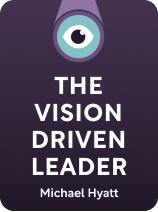

This article is an excerpt from the Shortform book guide to "The Vision Driven Leader" by Michael Hyatt. Shortform has the world's best summaries and analyses of books you should be reading.
Like this article? Sign up for a free trial here.
How do you create a vision that truly motivates and inspires? What’s the best way to go about developing a compelling vision that others will eagerly support?
In The Vision Driven Leader, Michael Hyatt breaks down the vision-drafting process. He focuses on how to make your vision motivational, how to make it compelling, and how to get into the right mindset for crafting your vision.
Read on to discover how to create a vision that will transform your organization’s future and inspire others to join your journey.
How to Create a Vision
According to Hyatt, there are three steps to establishing and implementing your vision: 1) create your vision, 2) get others on board with your vision, and 3) execute your vision. The first step to putting your vision into practice is to create it. Hyatt explains that a good vision must be motivational and compelling. We’ll explore Hyatt’s advice on how to create a vision, including a few tips on getting into the vision-crafting mindset.
A Motivational Vision
According to Hyatt, the most foundational feature of a motivational vision is that it’s something you genuinely want to achieve. You have to desire the future that your vision describes in order for it to motivate you. The more motivated you are and the more conviction you have that this is where you want to go, the more likely you’ll be to motivate and convince other people as well.
(Shortform note: The self-determination theory explains why desire can be so motivating for both you and others. When you desire the future that your vision describes, you satisfy your psychological need for autonomy: Aligning your vision with your values increases your sense of control over your life. Furthermore, the principle of emotional contagion explains why a leader’s conviction can influence others. This psychological phenomenon suggests that emotions can spread from one person to another within a group, meaning that a leader’s genuine enthusiasm for a vision can be contagious, increasing the likelihood of motivating and convincing others to support the vision.)
Pinpoint your desired vision by asking yourself what you want your future to look like, specifically focusing on four areas: the team, the product, the marketing, and the outcome.
Team
The people on your team are the ones who can make your vision a reality, so consider what kind of team you want to have in the future. Consider things like personality and the expertise of team members, as well as how the company will meet their needs.
For example, if your company makes video games, you may decide you want team members who are creative and determined and who seek out learning opportunities. You could commit to supporting them by allowing unstructured creative time and frequent chances to offer feedback at every level of the organization.
(Shortform note: In Surrounded by Idiots, Thomas Erikson explains that people can be categorized into four main personality types: red, yellow, green, and blue. Each of these personality types brings unique strengths to a team. Red personalities are often assertive and results-oriented, while yellow personalities are enthusiastic and creative. Green personalities provide stability and harmony, and blue personalities are detail-oriented and analytical. He suggests that, ideally, a professional team should include all four of these personality types.)
Products
Ask yourself: What kind of products do you want to offer? What products will help you achieve your vision? This isn’t something specific like, “We design video games,” but rather it’s about the value you want to offer to customers. For example, “We offer consumers a unique type of recreation and entertainment.” You can then expand with details like, “We offer consumers a way to connect with others like them and immerse themselves in powerful storytelling.”
(Shortform note: The elaboration likelihood model may explain why focusing on the product’s value rather than the product itself can be more motivating. According to this model, people process information in one of two ways: the central route and the peripheral route. People use the central route—which is logical and fact-driven—when the information they’re processing is well-elaborated, allowing them to make decisions based on provided information rather than logical shortcuts and general impressions (as in peripheral route processing). When using the central route, people are more likely to focus on a message’s strengths and are therefore more likely to be persuaded by it. A value-focused approach to your product requires a lot of elaboration, which encourages central route processing and thus increases its persuasive and motivational power.)
Marketing
Hyatt specifies that this is more philosophical than technical. What kind of relationship do you want with your customers in the future? What kind of customer relationship will help you fulfill your vision? For example, “We create profound experiences in our advertising that captivate our consumers. We nurture customer relationships through personalized and meaningful interactions.”
(Shortform note: Hyatt’s perspective on customer relationships aligns with broader marketing philosophies that emphasize understanding and connecting with customers on a deeper level. In All Marketers Are Liars, Seth Godin suggests that good marketing appeals to a customer’s worldview. His approach involves crafting messages and experiences that resonate with the beliefs, values, and perceptions that customers already hold. As you form the marketing aspect of your vision, consider the worldview of the customer groups you’ll be appealing to.)
Outcome
What results do you want to achieve by fulfilling your vision? For example, “We’re reshaping the way consumers engage with storytelling and how the market responds to their needs.”
(Shortform note: Psychological research supports Hyatt’s advice to envision your vision’s outcome. The expectancy theory of motivation suggests that motivation is driven by the expectation of positive outcomes. By clearly defining their desired results, leaders create a clear link between effort and valuable, positive outcomes, increasing motivation throughout the organization.)
| Creating Personal Vision Statements While Hyatt’s focus is on business, his approach to creating a motivational vision can be effectively adapted by individuals to enhance their personal lives and goals: You visualize your ideal future in terms of personal growth, relationships, and achievements. For example, you might apply Hyatt’s four-area focus to your personal life: envision your ideal support network (team), the skills or products you want to develop (products), how you want to present yourself to the world (marketing), and the impact you hope to make (outcome). |
A Compelling Vision
Hyatt explains that your vision must also be compelling. Your goal is to encourage people to work for a better future—but if people aren’t inspired or excited by your vision, they won’t care enough to put in the necessary work. You have to galvanize people to make your vision a reality.
Hyatt says that a compelling vision is extreme and challenging, but not reckless.
Extreme
Your vision needs to be a completely new, ambitious idea because gradually improving an existing idea step-by-step isn’t exciting.
(Shortform note: While gradually improving an existing idea may not be as exciting as working toward a new, ambitious idea, experts suggest that businesses shouldn’t overlook the value of gradual improvements. They note that incremental innovation, in which change is achieved through consistent, cautious forward progress, is essential for growing and protecting your business. It can lessen the risk of innovation, can help you diversify your products or services and remain competitive in your market. Thus, leaders may want to balance their extreme vision with incremental innovation to avoid losing track of immediate progress.)
Challenging, But Not Reckless
If you make reckless decisions, your company will likely fail. When refining your vision, make sure it’s not likely to fail, alienate your team or stakeholders, or harm your mission.
(Shortform note: The goal-setting theory can explain why a challenging goal is so compelling. This theory, developed by psychologists Edwin Locke and Gary Latham, suggests that challenging goals, particularly specific ones, lead to higher performance than easy or vague goals. Challenging goals energize people and prompt them to invest more effort into achieving them. Additionally, goals are more compelling when they’re clearly defined: when they’re communicated to others, agreed upon, and linked to deadlines.)
Get in the Right Mindset for Crafting Your Vision
Hyatt offers some advice on how to get started on developing your vision.
- Disconnect from your daily work and work environment. This gives you the mental space needed to see the present more clearly and to sit and imagine the future—reorienting from the short term to the long term. Hyatt recommends going somewhere you won’t be interrupted and not allowing yourself to think about other work until you’ve finished.
- Recognize your expectations, and don’t let them stop you from imagining a better future. Negative previous experiences may make you expect that the future can’t be better—demotivating and trapping you in your present circumstances. Instead, try seeing them as motivating: The only way to go is up.
- Don’t worry about how you’re going to achieve your vision yet. Let your imagination go wild: What would your future look like if everything went perfectly? Once you have your vision, you can worry about how you’ll fulfill it, but if you don’t have a goal, you won’t be able to plan the steps to reach it.
| The Psychological Basis of the Vision-Crafting Mindset Hyatt’s recommendations for how to get in the mindset to craft a vision are supported by psychological principles. The advice to disconnect from daily work and environments when crafting a vision is reflective of cognitive load theory, which states that your limited working memory affects your ability to process information effectively. In familiar work environments, you’re often bombarded with cues that trigger thoughts related to immediate tasks. This reduces your capacity for long-term, strategic thinking. Disconnecting can reduce your cognitive load and free up mental energy to help you design your ideal vision. Hyatt’s explanation of how negative experiences can keep you from envisioning a better future closely resembles learned helplessness, when individuals, due to past negative experiences out of their control, believe that all situations are out of their control. By encouraging you to see past experiences as motivating rather than limiting, Hyatt is helping to foster a belief that you can improve your future through learning. Finally, Hyatt’s recommendation to be imaginative without worrying about implementation aligns with the concept of divergent thinking, a cognitive process that involves generating creative ideas by exploring many possible solutions. You can foster divergent thinking through exercises like freewriting, mind mapping, and brainstorming alternate uses for a single item or idea. Additionally, by encouraging readers to envision a perfect future scenario, Hyatt is promoting “blue sky thinking,” a process of thinking about the future without limitations to generate new and unconventional ideas. This type of thinking is often used in business settings to foster innovation. The premise of blue sky thinking is that a single idea will lead to more ideas, resulting in a cascade of idea generation. To make the best use of it, focus on coming up with as many ideas as possible without judging or discarding them if they don’t seem feasible. |
Exercise: Compose Your Vision Statement
A vision can be an essential driver of your personal or professional success. Use Hyatt’s advice to craft a vision statement for yourself or your company.
- First, get yourself in the right mindset. Set aside your daily work. Then, think about the future you want versus the future you expect. Brainstorm as many ideas as you can for your potential vision without getting hung up on how you might achieve it.
- Next, picture what you want for your future in three to five years from now. What major improvement do you want to see? What future will keep you motivated as you do the hard work of achieving it?
- Now, consider the four important areas of focus Hyatt describes: Ask yourself what kind of team you need, what value you’ll offer to your customers or your future self, how you want to present your company or yourself to the world, and what ultimate results you want to see.
- Finally, put together a statement of your vision. Make it ambitious, compelling, and clear enough that you could explain it to a layperson. Place your vision statement somewhere conspicuous so you can see it every day, and allow it to guide your actions toward the future you want.

———End of Preview———
Like what you just read? Read the rest of the world's best book summary and analysis of Michael Hyatt's "The Vision Driven Leader" at Shortform.
Here's what you'll find in our full The Vision Driven Leader summary:
- How to turn a failing organization into a thriving success
- The benefits of having a strong vision as a business leader
- How to sell your vision to your team, superiors, and peers






